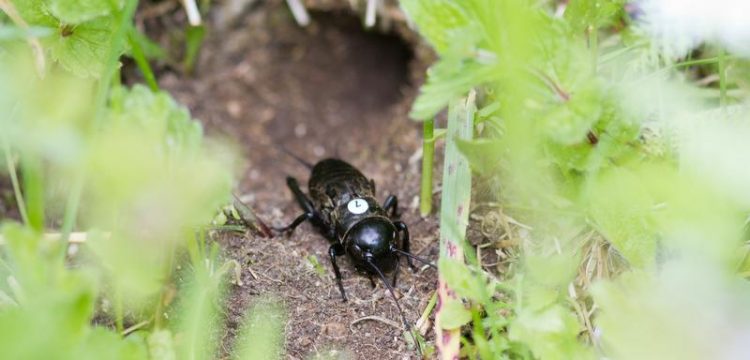Bold crickets have a shorter life

A cricket in front of its burrow. For identification, the researchers marked it with a painted spot on its back. Petri T. Niemelä
Animals, like humans, have distinct personalities that are partly defined by genes and partly shaped by the environment. Personality as a phenomenon means that some individuals are consistently more shy, bold, cautious or aggressive compared to others.
During the last decade, different individual personality patterns have been detected in more than 100 animal species and found to be related to important life history traits such as reproductive success and survival.
Studying personality in the wild is important since it ensures that the behavioural expression as well as ecological data (such as longevity) are collected in a natural environment and thus not affected by artificial experimental setups used in the laboratory. Most studies of the relationships between personality and survival have been conducted on established vertebrate models such as mammals and songbirds and there are few studies, if any, on invertebrates in wild populations.
Scientists, led by Niels Dingemanse, from the Max Planck Institute for Ornithology in Seewiesen and the Ludwig-Maximilians-University in Munich have investigated the personality and survivorship in wild field crickets. Within a 120 m² fenced-off meadow, cricket nymphs were individually marked and monitored until they reached adulthood in order to study their individual behaviour and survival.
For example, flight initiation distance, i.e. distance when crickets initiate the escape of an approaching thread, was determined by tapping a round wooden pole on the ground towards the cricket’s burrow mimicking natural ground predators that prey on this insect.
Together with the measurement of the maximum distance that crickets moved away from their burrows these behaviours were used to define whether crickets express personalities. As predicted, bold behaviours varied consistently between individuals, verifying the presence of personality.
Bold field crickets suffered from higher mortality compared to less bold ones probably because they are preyed upon by natural predators such as shrews and birds more often compared to shy individuals. Furthermore, bold individuals were more easily detected by the observer which likely represents the mechanism for their higher mortality: predators can detect bold individuals more easily.
To verify that observers did not simply miss the shy individuals, the researchers fenced the burrows and repeated the measurements. “These differences in the encounter rates between bold and shy individuals should be considered in future studies investigating relationships between personality and fitness in natural populations”, says Petri Niemelä, first author of the study. (SL/HR)
http://beheco.oxfordjournals.org/content/early/2015/04/15/beheco.arv036.full
http://www.mpg.de/9192793/personality-related-survival-crickets
Media Contact
All latest news from the category: Life Sciences and Chemistry
Articles and reports from the Life Sciences and chemistry area deal with applied and basic research into modern biology, chemistry and human medicine.
Valuable information can be found on a range of life sciences fields including bacteriology, biochemistry, bionics, bioinformatics, biophysics, biotechnology, genetics, geobotany, human biology, marine biology, microbiology, molecular biology, cellular biology, zoology, bioinorganic chemistry, microchemistry and environmental chemistry.
Newest articles

Sea slugs inspire highly stretchable biomedical sensor
USC Viterbi School of Engineering researcher Hangbo Zhao presents findings on highly stretchable and customizable microneedles for application in fields including neuroscience, tissue engineering, and wearable bioelectronics. The revolution in…

Twisting and binding matter waves with photons in a cavity
Precisely measuring the energy states of individual atoms has been a historical challenge for physicists due to atomic recoil. When an atom interacts with a photon, the atom “recoils” in…

Nanotubes, nanoparticles, and antibodies detect tiny amounts of fentanyl
New sensor is six orders of magnitude more sensitive than the next best thing. A research team at Pitt led by Alexander Star, a chemistry professor in the Kenneth P. Dietrich…





















